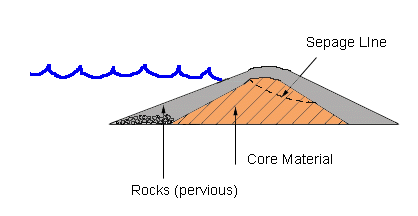|
The main force on an embankment dam is the force of the water. The
weight of the dam is also a force, but each material has a different
weight, so it is not shown here as one force the way it is on the concrete
dams. The uplift force is also acting on the embankment dam, but some of the
water seeps into the dam so the force is not the same as on a concrete dam.
Roll over the water force to see it on the dam. Click to learn more
about it:
 |
|
The embankment dam is the only dam type we are introducing that is not made of
concrete. Embankment dams may be made of earth or rock, both of which are
pervious to water -- that is, water can get into it. You see above that
the water will seep into the core material and should stop at the seepage
line. The core material is usually more watertight that the rock or earth
that is on the outside of the dam, but the core material is still not totally
impervious to water. Concrete is not truly impervious either, but it does not
allow as much seepage as these materials do.
The diagram shown above is only one configuration of what an embankment dam
may look like. It could be any combination of earth, rock, and core material
in any number of arrangements.
Other forces that may act on an embankment dam are:
- there may be water on the downstream side of the dam as well;
this water will have the same sort of vertical and horizontal forces on the
dam as the water on the upstream side
- internal hydrostatic pressure: in pores, cracks, joints, and seams
- silt pressure; silt will build up over time on the upstream side; silt
provides about 1.5 times the horizontal pressure of water and twice the
vertical pressure of water
- ice load on the upstream
side
- wave load on the upstream side
-
earthquake loads
- settlement of the foundation or abutments
- other structures on top of the dam -- gates, a bridge, cars
back to top
|


